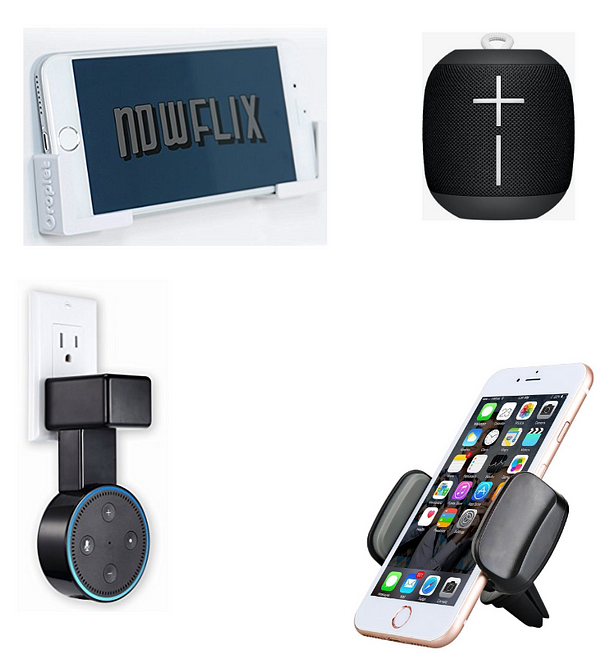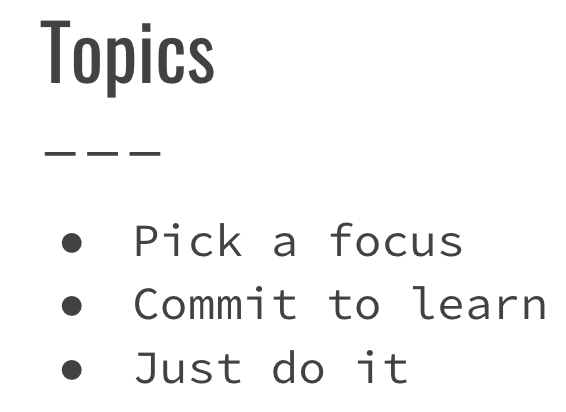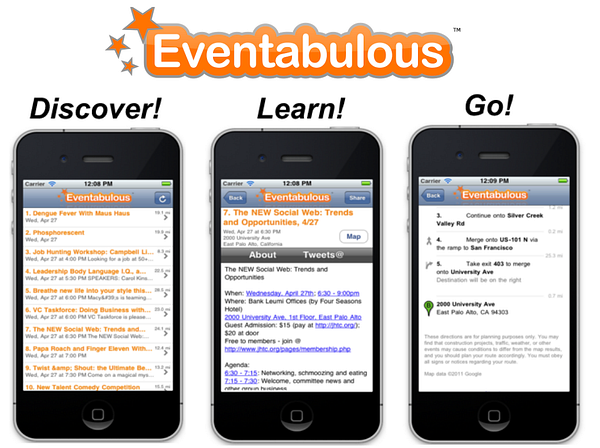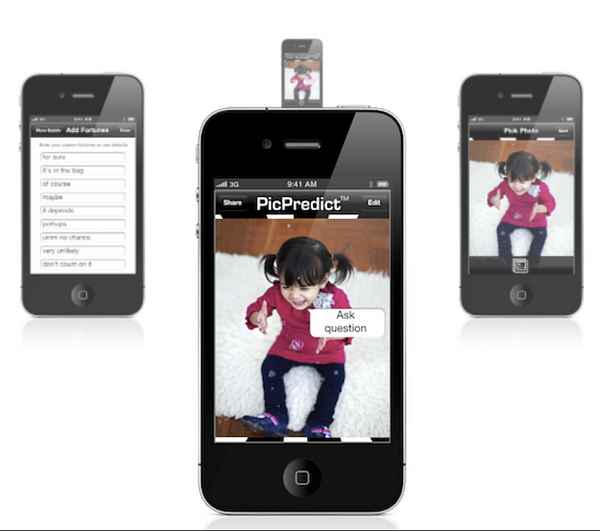VIDEO
At Girl Geek X Elevate, Oath Director of Product Management Sophia Perl covers how to stay current with new technologies and business models in the constant pursuit of knowledge, relevance and fun. Staying up-to-date with industry trends, new tools and emerging technologies can seem like a full-time job — but it doesn’t have to be.
Speakers:
Sophia Perl / Director of Product Management / Oath
Angie Chang / CEO & Co-founder / Girl Geek X
Transcript:
Angie Chang: Hi everyone, welcome back. It’s Angie Chang here. We have, today, Sophia Perl, Director of Product Management at Oath. She will be talking to us about how to stay relevant in the tech economy.
Sophia Perl: Ah, thank you Angie. Hi everyone. I’m Sophia. I’m here to share with you top tips for staying relevant in the tech economy. Some of the topics that I’m going to cover are, the first one is where can you find inspiration for figuring out what you should learn more about? The next, I’ll share with you some of my tips of how I set up my home environment to really encourage, and commit myself to learning. Then lastly, I’ll share with you some stories where I’ve applied newly skilled, newly learned skills to side projects, and even at work. I just want to warn everyone too, my slides are full screen so I can’t see all the comments that are happening. But, Angie is here to help me, so she’ll let me know if there’s anything that you guys are talking about that I should know about.
All right, so a little bit about myself. I work at Oath. I previously have worked at Ebay and IBM, in a variety of engineering and product positions. I’ve worked in ads, marketplaces, identity, and databases. On my personal side of life, I am one half of a full-time working couple. I do have kids, and I am known for breaking or bruising parts of my body from snowboarding. No, they’re not from doing the half pipe. It’s really just trying to get to the bottom of the hill. All right, let’s get started.
How many of you have seen this Atari Breakout game? One of the things that I love about this game, is how similar it is to our industry, and to our roles and responsibilities. Imagine that you’re this paddle at the bottom of the screen going back and forth. The ball is a skillset, and the blocks are tests that you have at work. As you’re going about in your day, you’re knocking out these tasks with all these skillsets that you have in your toolbox.
Every once in a while, your skillset, you don’t have that skillset. And so, you find it more challenging to tackle these tasks. This is how I think about the tech industry especially. There’s so many things that are changing, and it’s hard for us to keep up. I know for me personally, I’m always trying to learn things. And, always not having the time to do and learn everything, it’s been quite a challenge.
That brings us to, we’re super busy people. This is pretty obvious. There was actually a study done by the US Bureau of Labor, who looked at how much time does a working professional spend on any given day? What you’ll see here is, for educational activities, we spend less than seven minutes a day. Then, if you take a look at leisure and sports which is just a couple rows down, we’re spending up to four hours on leisure and activities. I mean, I get it. We all need to relax, and work out. But, I think there is some focus that maybe we need to shift some of our time for educational activities.

Another related study, this is by the Pew Research Center: 63% of us consider ourselves life learners. I would like everyone, just mentally ask yourself, “What bucket of learners are you? Are you a life learner, or are you a non life learner?” As we look at articles, and additional studies, we know that we need skills for the future. One of those skills is life learning — being able to consume information continually, and sort of adapt with our changing environment. We also know that people who are life learners, do benefit in the workplace. They’re able to expand their professional network, advance within their current, in their organization.
Up until this point, we’ve established that our industry is continually changing, our roles and responsibilities are continually changing. We don’t have a lot of time to dedicate to learning, but we know that for the future, we need to be a life learner, and we know that life learners do benefit in the workplace. So now, what I want to do is share with you some of my tips on how to get us into life learning mode.
The first topic is, where do you look for to pick a focus for what you want to learn more about?
Now, this slide I would say is more of a baseline. I hope it’s nothing new for many of you, but it’s really understanding what’s going on in your industry, your company, the competitors, and even your role and responsibilities yourself. You could get a lot of this information from news blogs, and newsletters. But, most importantly, if you’re thinking about perfecting your craft, someone actually gave me this idea where they said, “Hey Sophia, if you really want to understand what it takes to be a great PM at different companies, or even at your own company. Start being an interviewer.” So, start thinking about sort of a forcing function. Think about what I would look for in a person in terms of their skillset, and how would I assess that this person possesses these skills? And, is it a good fit for the team that we’re hiring for, for Oath? Also, is it a good fit for the company?
If some of you are not doing interviews on behalf of your company, I highly recommend that you do that. Because, it does sort of forces you to think more about assessing yourself, and also assessing what is a great fit for the team, and the company that’s hiring. My personal favorite on where I could find inspiration on what I should be learning about, is really tapping into my professional, and my friends network. What I mean by this is, earlier we established that everyone is super busy. Why not have people do the heavy lifting for you?
Every once in a while I’ll reach out to my friends, or my professional network and I’ll ask them, “Hey, what are you currently learning? What do you think I should be learning?” It’s super relevant when you are reaching out to folks who work in the same industry that you’re in, or even the vertical. And, who are doing similar roles and responsibilities as you. I highly recommend reach out to your personal network, have them do the heavy lifting, and see what curated lists they already have. And, use that as another set of ideas.
Lastly, as all of us, I’m assuming all of us here are leaders, are really aspiring to be leaders. One of the things that I highly recommend, and has worked very well for me, is consider taking a self-assessment. What this helps you do is really understand that under the hood, why do you operate the way you do at work? Understanding your communication style, how you collaborate with others. About, I would say two, three weeks ago. I actually took the Insights Discovery Test. The way this test works is, it sort of identifies which colors you’re most comfortable operating in. You have cool, blue, red, yellow, and green. Usually people fall into two to three colors in terms of your colors that you’re most familiar with, the ones that you sort of leverage naturally.
What I liked about this is, it sort of informed me what colors that I fall into. But, it also talked about how I should be perceiving others, and what colors they may be, and how I would interact with them coming from a different color perspective. Again, we sort of went through looking at your industry and company, we looked at maybe even perfecting your craft specifically for your role and responsibilities. Then lastly, looking at so sort of soft skills. How do you like to operate? This is really relevant for people who want to move up in the leadership track.
All right, so the next set of tips that I have, is how do you set up your day to day life to help you commit to learn? Once you figure out what you want to learn about. Again, that’s a very personal choice, depends on what skillsets you have. When you figure that out, then it’s looking at, “Okay, how do I make the time in my day so that I’m continually learning?”

This diagram I ran into recently and I really like it — by the author Edgar Dale. What it talks about is, that there’s many different methods for learning. What he advocated is that, you want to leverage multiple methods so that you can show, learn the breadth and the depth of a particular topic.
If there’s one thing that you take away from my talk, this is the one thing I would want you to take away. I think we all have learning methods that really resonates well with us. Meaning, when we learn through a certain method, the content sticks a lot. If it’s something similar to what I go through, that’s usually reading a book, or taking a class. But, I would love everyone to open up your minds, and think about, look.
You could either wait for that perfect moment where you dedicate a lot of time, and maybe energy to do your preferred learning method. Or, you could actually maybe … I would say get your second or third best learning method.
I’ll show you that in the next slide. But, think about finding opportunities where the learning method meshes more well with your day to day life, instead of finding that perfect moment where you have to dedicate a lot of time to learn about something. That’s just something to keep in mind.
I’ll give you an example in the next slide. All of these apps I’ve used one point in my life. The one that actually sticks out the most is OverDrive, which is a free version of Audible. Audible is the monthly subscription that you get on Amazon. You pay $15 a month for access to a bunch of audio books. OverDrive is actually connected to your local library. If you don’t have a library card already, I encourage all of you to go get a local library card. Then, hook it up to OverDrive. What OverDrive allows you to do, is to download eBooks, or download audio books for free.
I did a side-by-side comparison between what I could find in my library, and what I could find at Audible. I found about 70% to 80% of the books that I was personally interested in, I could find for free on OverDrive.
Consider leveraging apps to help make it easier to consume information.
All right, so on this slide, in conjunction with leveraging apps you want to think about what devices you want to be using, and for when you would use those devices. This is a … Angie, this is one of the times I’m going to ask people questions here. She’ll sort of summarize.

For me, on the left hand side, this is my setup. In the morning, I would love people to guess, where do you think this is, like what room in my house? Bonus points if you could tell me specifically in what area in the room do you think this setup is? In the morning, I have an Echo Dot, I have two waterproof speakers, and I have an iPhone holder.
Angie Chang: In the shower? Someone said the kitchen.
Sophia Perl: Yes. Kitchen is actually a good one. I do have an Echo in the kitchen, but yes. This is in the shower. I don’t do this all the time, but I have been known to watch YouTube videos of people lecturing, or different workshops. I have it pressed up to my screen, or to the glass of my shower door. Then, I listen to the talks while I’m in the shower.
If you think about it, what times do you have where you could actually listen to content? For me in the shower, I’m spending 15, 20 minutes in the shower. Then, you could read the rest driving, and in the evenings.
In the evenings, it’s great for me because I’m actually not multitasking as much. But, after I’ve put my kids to bed, and later in the evenings, that’s when I find time to meet with people who are more flexible in terms of meeting late evenings. I have my laptop and phone so I usually do Hangouts, and so forth.
If you are considering leveraging devices, which I highly encourage, think about leveraging IOT devices, because you’re sort of killing two birds with one stone. You’re using it to consume information, but then you’re also leveraging it to be an early adopter of an IOT technology, like tech gadgets.

All right, so the last section is, just do it. I want to give you some examples of how I’ve taken what I’ve learned recently, and apply it to side projects, and at work. Here is my first example. When I first coded my first IOS app, I was PM at the time. I had attended two Hackathons. Made some friends along the way who ended up being my mentors , and I also got a bunch of books, and a Macbook to code apps.

My first app that I coded is, I called it, “Eventabulous.” I still have the domain name, so that’s super. Eventabulous.com. It doesn’t do anything but show this app. What it does is, I was really into events, and I loved networking. I thought, “Why not put that passion and apply it to something that I’m also trying to learn about?” — which is developing apps. What it does is, based on your current location it will tell you events that are located near you, within 20 to 30 miles. It will show you nearby Tweets. I was thinking, “Hey look, if I can monitor the tweets near the location, maybe it tells me if it’s a good or bad event.” Then lastly, you get directions to event. I was leveraging, at the time it was Yahoo Upcoming Events API. I was leveraging the Twitter API, and I was leveraging the Google Maps API.

The second app that I ended up coding, was actually had got better adoption. It was surprisingly, it’s called Pic Predict. It was a picture fortune telling app. Every week I actually consistently got 20 to 40 downloads. I completed the app during my maternity leave, so I was towards the end, when I was getting a little bit more sleep. Fun fact, this app used to be called, “Magic Create Ball.” I was trying to spin on sort of a flexible Magic 8 Ball. If any of you know the Mattel Magic 8 Ball where you shake, and it sort of says your fortune. I did have that name, and then iTunes rejected it because of trademark, so I had to change it to Pic Predict.
Yeah, I made two apps. Really it was for fun, but I really, I would say the lessons learned from going through this process is, I wanted to build something from idea, to market. I did everything on my own. I came up with the graphics, and I coded everything. It was a great experience. I would say it was my first foray in mobile apps in general.
I want to share another example, and this one is more relevant to work. It’s a small example, and it’s more just to show you that it doesn’t have to be a big project, or big thing that you have to apply this new skill too. You just need to find small ways where you’re incorporating things that you’re learning outside of work. This one in particular, I really wanted to hone in on my brainstorming skills. I was asking around on a Women In Product Slack group like, “What are some of the ideas, or what should I be referencing?”
Someone recommended this Sprint Book, which is the Google Design Sprint. Basically, it talks about a five day process where you go from idea to proto-test, and prototype, and putting it in front of a customer at the end of the week. I read more about it, and I actually had friends who had taught workshops on this. It was great that I had friends that were teaching people, and had also applied it at work. I ended up using it to generate ideas for a product roadmap. The results of that, I actually, a lot of the ideas that came out of it, ended up on my roadmap. I also had people who had never done it before, who told me they really enjoyed the process. I ended up being a doer and a teacher for this project, so that was pretty cool.
All right, so before … Actually, one more thing I want to put before I go to this slide is, as you think about the trends, and the technologies that you’re learning outside of work.
One of the things that I also try to do, is think about how does that technology apply to work? And, maybe it doesn’t apply initially to work, maybe it’s more thinking big box, unlike how would you use the technology?
To give you an example, I work in ads. How would self-driving cars be applied to ads? Is it ads showing up on the speaker, ads on the outside of the car? I mean, it really gets your juices going, and it gives you really a broader perspective on what you could bring to the table when you’re talking with your colleagues, when you’re brainstorming ideas.
I would also recommend thinking about pulling apart the technology. I’ll just stick with self-driving cars. It has sensors, different cameras. How can the image recognition be applied to something that you’re doing at work? It may not necessarily be self-driving cars in its entirety, but maybe it’s parts of it that could be applied. That’s another tip to keep in mind.
All right, so let’s go to this slide. You could benefit from showing off your newly learned skills. As I sort of explained a little bit earlier, you solidify your learning by doing, and also by teaching. Eventually, that makes you a subject matter expert in the area. Think about that, about how you could bring your outside skills, and use that at work. Then, become more relevant as your team is looking to build skills in certain areas. Maybe you actually lead that initiative at work.
Then lastly, I know from personal experience that I have gotten notice by hiring managers. As I talked about those two apps that I had worked on, that was during the time that I was at IBM working on very large scale enterprise software. The apps showed another side of me that other companies weren’t considering. Which is, “Hey look, she could build consumer apps, she understands the consumer side of the house.” That’s something to keep in mind as well.
All right, wrap up. We went over how to pick a focus, how you could commit to learn, and how you could just do it. Applying what you just learned to the workplace, and maybe even side projects. That’s it.
Angie Chang: Okay Sophia, I think we are out of time. That was a fantastic presentation, got a lot of great feedback in the chat here. If you would like to answer questions you can answer them on Twitter, and hashtag them GGXElevate, and people will retweet them, and people can get your answers. We have to move on now to our next speaker, so thank you so much for coming and joining us for this fantastic presentation.
Sophia Perl: Yeah, thank you. Thank you for having me.
Angie Chang: All right.
Sophia Perl: Super.
You can find Sophia Perl’s Girl Geek X Elevate presentation slides here


